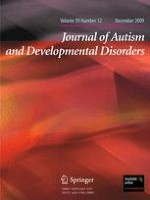01-12-2009 | Original Paper
Identifying Symbolic Relationships in Autism Spectrum Disorders: A Deficit in the Identification of Temporal Co-occurrence?
Gepubliceerd in: Journal of Autism and Developmental Disorders | Uitgave 12/2009
Log in om toegang te krijgenAbstract
Individuals with Autism spectrum disorders (ASD) experience difficulties understanding the non-verbal cues conveyed by others that provide symbolic information about relationships between self, other, and environmental events. This study examined whether these difficulties reflect underlying problems in the identification of temporal co-occurrence, or in memorial, associative, or inference skills. The performance of a group of adolescents with ASD was compared to that of typically developing children and adolescents with learning difficulties on four tasks assessing these processes. The ASD group experienced specific difficulties when they were required to identify relationships signalled by the temporal co-occurrence of stimuli. These results are discussed in relation to theories of conceptual deduction in ASD, and a hypothesised role in social cognitive development for attention processes is outlined.
